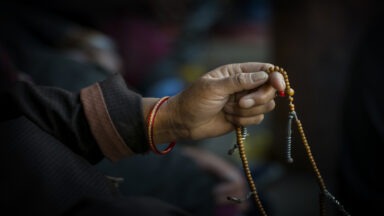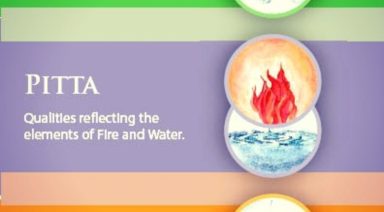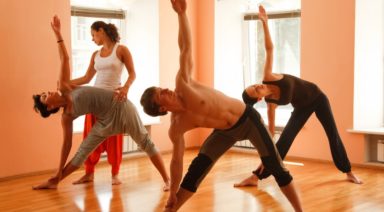The Secret of Namaste

Namaste: I honor, respect, recognize and bow to the light in you and me.
This sacred gesture, used in many yoga practices, meditations and prayers, holds a secret wisdom. When the mind and senses bow to the Heart Chakra, the union between body and soul is achieved. The key, however, is to go deep into the Heart Chakra where the soul glows its life-giving presence, bringing breath and heartbeat to your body.
The Heart Chakra
Why does one need to go deep into the Heart Chakra, and how does one achieve this process? The reason for going deep into the Heart Chakra is to guide the senses that are controlled by the mind and also control the mind, into the Heart.
When the senses are only aware of the life around your body, the senses cannot be fully aware of your soul in the Heart Chakra. The senses must be withdrawn; in Yoga this is called “Pratyahara.”
By withdrawing the senses, your mind’s awareness turns inward. To withdraw the senses and still be in the mind is not pratyahara.
True pratyahara is withdrawing the senses from the outer story of separateness, into the inner Truth of oneness that glows in your heart.
Essence of Oneness
The experience of oneness is held in the Heart Chakra, not the mind. The feeling that reveals you are in oneness is pure love. Love not based on the material world image, but the pure true love between body and soul, creation and creator.
When the mind and its minion senses are gathered together and guided inward, the gifts of the senses are now in a different reality. This reality is called oneness, innerworld, intuition, soul, spirit, Divine, union, source, etc. The more focused the mind is in its ability to gather the senses, the deeper purity and truth of the experience of oneness — love. When the senses finally enter the Heart Chakra, the senses become calmer and more in your control.
Humility
The secret to this whole process of pratyahara, and going into the Heart Chakra requires humility. Humility is when the mind and the personality it created through senses (known as ego) have reached a willingness to change. The aspiration to transform and discover a new perspective of oneself and life is also the feeling of humility.
So how does one achieve pratyahara, humility and a focused mind, in order to discover what is inside the Heart Chakra?
New Technique for Accessing the Heart Chakra
A very special technique came to me in my mid-20s when I had reached a direction in my life where I was humbled and willing to change. This humility came forth due to the death of my parents in an aviation crash when I was a teenager and my sister’s murder shortly thereafter, resulting in my many illnesses and losing my will to live.
With these techniques, by bowing into the heart, I discovered the purpose for life and found self-love. The process of this technique begins with a beautiful feeling such as love. The ability to feel this feeling build in us is the presence of the Soul.
Remember, light is the image of love.
Mental Centering™ Technique by Savitri
Centering Mental Energy (1 ½ minutes)
Sit erect with your eyes closed. With the middle finger of each hand touching the front of each armpit, trace a horizontal line to the center of your chest. With the middle finger of your right hand touching your skin, you will feel a sensitive area on your sternum. Massage gently for a few minutes. This is your Heart Chakra, the doorway to your soul. Imagine light glowing lovingly in the Heart Chakra.
- With your eyes closed, place your hands with your fingers together, slightly cupped, on the right and left sides of your head, facing your ears. Your hands should be approximately 3 inches away from your head.
- Exhaling, move your hands together in Namaste, not more than 1 inch away from your face, with the tips of your thumbs at the same level as your eyebrows.
- Inhale. On the next exhalation move your hands down slowly to your Heart Chakra. As you do this, imagine your mind following a straight line in the center of your body and offer your mind to your heart.
- Say inwardly, “I offer my mind and senses to my loving soul within.”
- Do this technique 3 or more times and breathe slowly and peacefully.
Benefits
Increases the power of Namaste, intuition, self-love, respect, and conscience bringing calmness to the mind and body as they discover the soul’s presence.
Notice at the end of this technique the hands end up in Namaste. This is the exact energetics of what happens to us when we say Namaste or bring our hands in prayer. The mind withdraws its ego perception of another and bows inside the Heart Chakra to the true perception the Soul-Light holds.
The mind now is awakened to the love and light that is in your body; this always recognizes the love and light in anyone or anything.
The first level of enlightenment is to keep this connection consistent. Namaste is the energetics and action of self respect and respect for others. Respect is one of the keys to the teachings of yoga. This union of self-respect between mind, body and soul, and respect for others, is the feeling of love. And through this love the soul can shine freely through your body and to others.
Let the secret gift of Namaste bless your yoga journey on and off the mat. Namaste.
© Copyright 2015 by Savitri, all content, all rights reserved. Heartfull Meditation™ and technique trademarked by Savitri.
5 Tips to Reclaim Your Calm

Stress and anxiety have become everyday realities, especially over the last year. In fact, a survey conducted in 2020 reported that 62% of adult respondents reported experiencing anxiety on a regular basis. But what if it didn’t have to be that way?
Yoga, breathwork, and meditation can create a foundation of synchronicity in your body that allows you to regain control of your life in a way that calms your sympathetic nervous system (fight or flight response) and supports an overarching sense of calmness in our chaotic world.
These practices, while not a panacea for anxiety, can improve stress response, and have been clinically proven to do so. A recent study at New York University Grossman School of Medicine discovered that in a group of randomly selected people with Generalized Anxiety Disorder (GAD), 54% met the criteria for “meaningfully improved symptoms,” after practicing yoga.
So, what can you do to reclaim a peaceful mind and life? Here are 5 tips to get you started:
1.) Develop a regular physical yoga practice (or re-commit if you already have one)
All types of physical exercise are beneficial for decreasing stress response by improving the health of the cardiovascular system (also potentially reducing the risk of heart disease) and releasing endorphins. Yoga, however, offers a special twist of calmness and relaxation while still allowing an exertion of physical effort, creating a fertile environment to build self-awareness through mindful movement.
Because of the flexibility and strength gained through regular practice, joint and muscle pain may also be soothed through a physical yoga practice (also called Asana) by reducing stressors related to pain responses in the body. Over time, and with dedicated practice, these benefits add up dramatically, even to the point of correcting scoliosis or reducing heart palpitations. Vinyasa or Yin yoga are generally the most beneficial practices for these physical benefits.
One common misconception about yoga is that you must practice for an hour to benefit. This fallacy was derived from the fact that studio classes often run for an hour. Any amount of time spent practicing physical yoga counts, whether it be 10, 60, 90 minutes, or more!
2.) Practice 5-10 minutes of breathwork
Breathwork (or Pranayama) can be easily overlooked, even by seasoned yoga practitioners, but it is one of the most beneficial aspects of your practice. How we breathe is often directly correlated to how we feel; short and shallow breathing makes us feel closed off and more anxious, whereas long, mindful breathing creates a sense of abundance, while also promoting a more meditative and mindful state. Taking as few as five minutes a day to breathe deeply and mindfully can literally re-oxygenate the mind and body. This allows more clarity and direction in everyday scenarios, and (with the use of some specific practices, like this one), can create a space of time between a personal cause and retort, transforming reactions into more thoughtful responses.





































